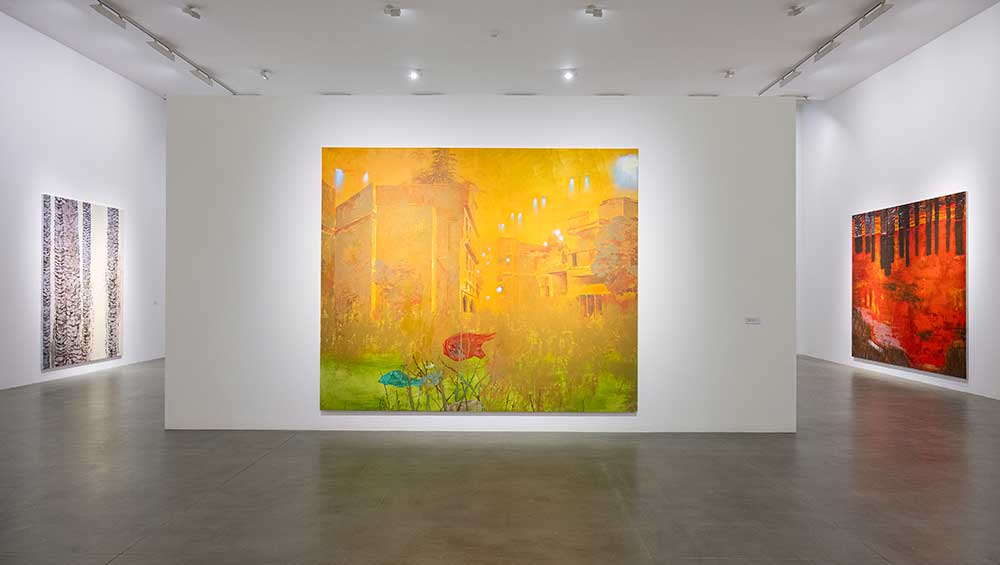
Mohammed Sami, Isthmus. Installation view, Fondazione Sandretto Re Rebaudengo, Turin, Italy, 19 March – 13 October 2024. Courtesy the artist and Fondazione Sandretto Re Rebaudengo. Photo: Giorgio Perottino.
Fondazione Sandretto Re Rebaudengo, Turin
19 March – 13 October 2024
by JOE LLOYD
In one of Mohammed Sami’s new paintings, we see a row of grooved compressions in an icy field. Some have been partially cleared of snow and ice, revealing a dark surface below. One, in the centre, is almost entirely black. Sami gives us little indication as to what exactly these channels are. But their arrangement, which surges to a point at the top of the painting, seems to indicate a road, a line that conveys us from one place to another. Sami’s perspective is not quite that of a driver with eyes on the road. It hovers above this channel and gazes down at it, as if hesitant to embrace moving forward. This work’s title, The No Return (2023), adds to this sense of unease. In its context, the snowy ground immediately evokes a conveyer to the gulag, a one-way trip to obliteration. But it could just as easily signify a more ambivalent journey, a crossing from one stage of life to another.
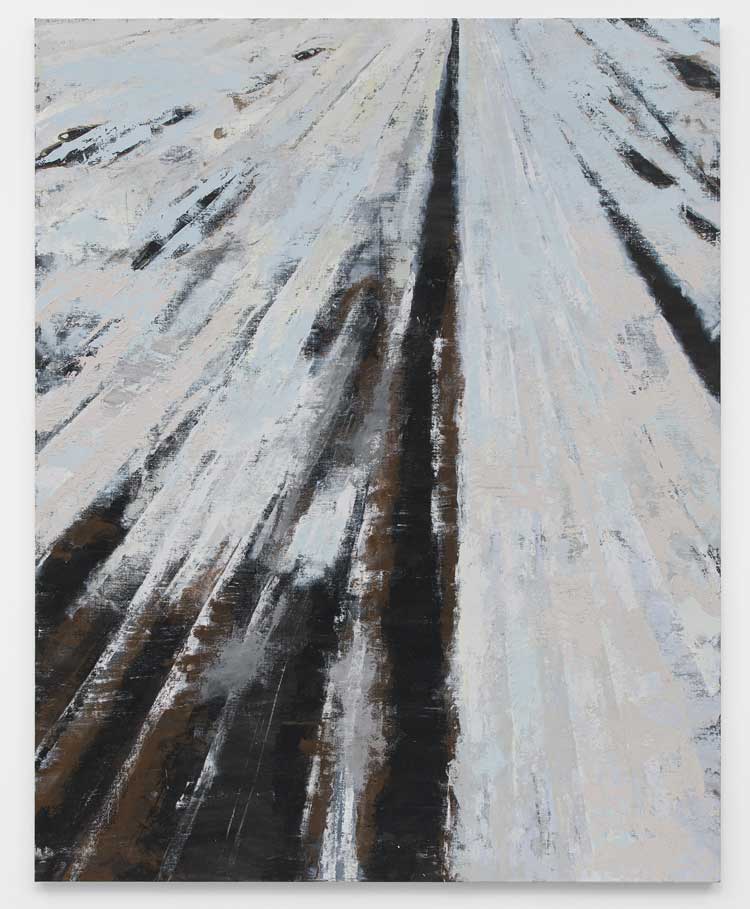
Mohammed Sami, The No Return, 2023. Mixed media on linen, 290.5 x 230 cm (114 1/8 x 90 1/2 in). Photo: Michael Brzezinski. Courtesy the artist, Modern Art, London and Luhring Augustine, New York.
Sami (b1984, Baghdad) is no stranger to such transitions. His 40 years have witnessed several turning points, some of them allowing no return. Sami grew up in Saddam Hussein’s Iraq, where he trained to paint propaganda murals and the portraits of the leader that adorned every home and workplace. He emigrated in 2007, in the aftermath of the US-led invasion. After a spell in a Swedish refugee camp, he moved to Britain, studying first at Ulster University and then at Goldsmiths, University of London. This past informs his art. “My work”, he said in a 2022 interview with Art Quarterly “is about belated memory, or belated response to memory.” Several of his pieces function in part as testimonies to his own past. There are interiors hung with portraits of Saddam, albeit with his face hidden in a blur (figures never appear in Sami’s work). The paintings in his Refugee Camp series often show a building bathed in amber light, concealed behind trees or just visible above a rock face, sometimes blurred out completely.
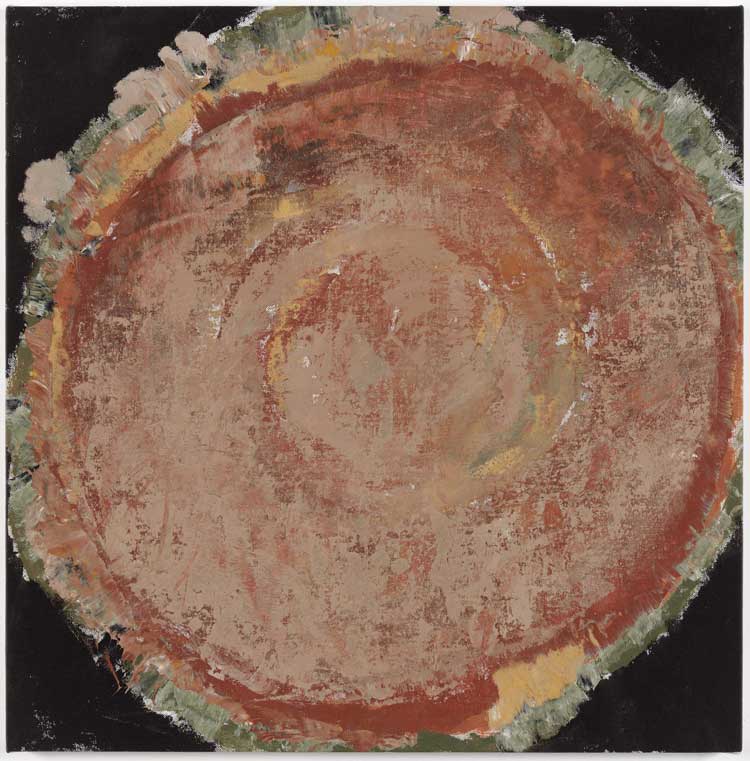
Mohammed Sami, Blind Cornea, 2023. Mixed media on linen, 66 x 65 cm (26 x 25 5/8 in). Photo: Marcus Leith. Courtesy the artist, Modern Art, London and Luhring Augustine, New York.
Sami’s profile has climbed steadily, with last year’s Camden Art Centre solo show representing a breakthrough. Isthmus, at the Fondazione Sandretto Re Rebaudengo in Turin, shows what Sami did next. It comprises works from 2023. Some of them are landscapes, albeit landscapes viewed from curtailed perspectives. Others present life closeup: Blind Cornea (2023) presents an opaque orb that nevertheless appears to gaze out towards the beholder. This flesh-hued circle does not much resemble an actual eye suffering from corneal blindness, but Sami’s paint, spray pink splattered over red over brown, captures the idea of something clouded over. In Under the Palm Trees II (2023), Sami captures the strangeness of palm trunks, a series of interlocking spines, protruding like a wall of shields.
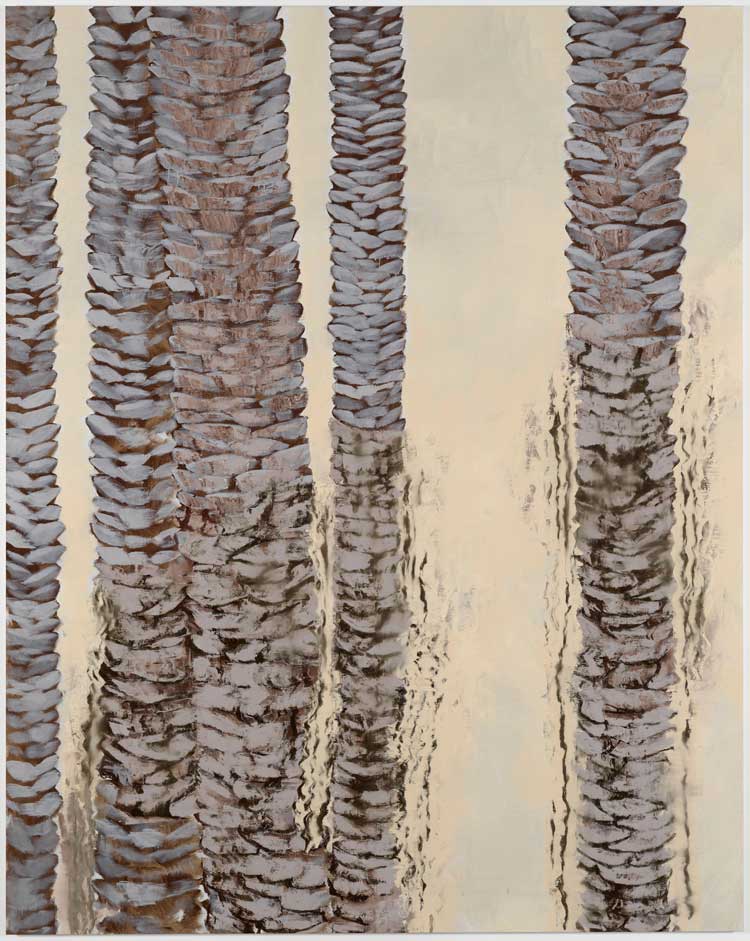
Mohammed Sami, Under the Palm Trees II, 2023. Mixed media on linen, 290 x 230 cm (114 1/8 x 90 1/2 in). Photo: Marcus Leith. Courtesy the artist, Modern Art, London and Luhring Augustine, New York.
An isthmus is a sliver of land that connects two larger areas. In the exhibition’s text, it is flipped to represent “a place that separates two things”, and related to the Arabic concept of Barzakh, a purgatorial state between life and afterlife. Many of these paintings seem to leave us suspended just before or after a crisis.
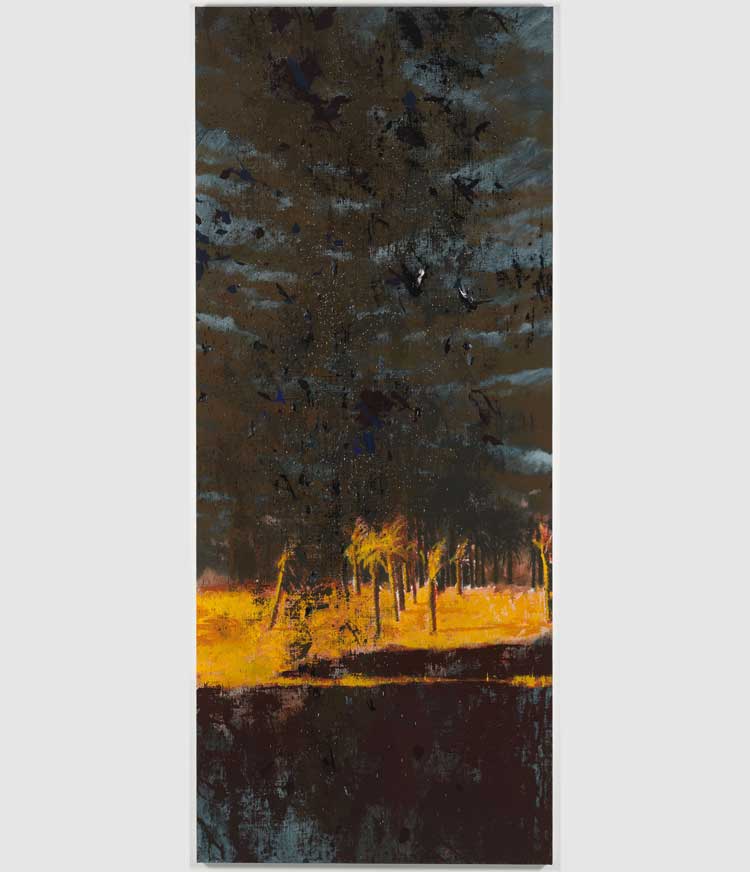
Mohammed Sami, Ashfall, 2023. Mixed media on linen, 230 x 95 cm (90 1/2 x 37 3/8 in). Photo: Marcus Leith. Courtesy the artist, Modern Art, London and Luhring Augustine, New York.
Ashfall (2023) centres on a sparse palm grove illuminated by an explosive flash, rendered in yellow and orange paint that rips through the scene like wildlife. Above, darkness reigns. As above, so below. Little dabs of ash flutter down, white against the gloom, like snowfall. Has there been a volcanic eruption, a conflagration, or an explosion? Under the Palm Trees (2023) presents what might be a different perspective on the same scene. The trunks of palms are reflected in sticky blood-red water, its colour reflecting a torrid sky. We can make out the windows of a burning building in the murk.
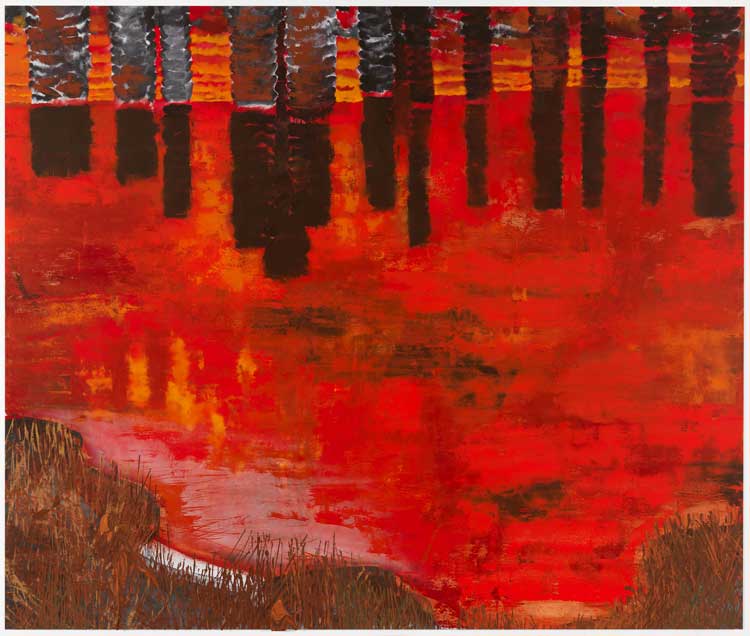
Mohammed Sami, Under the Palm Trees, 2023. Mixed media on linen, 290 x 344.5 cm
(114 1/8 x 135 5/8 in). Photo: Marcus Leith. Courtesy the artist, Modern Art, London and Luhring Augustine, New York.
The images that remain in our memory are often obscure. TS Eliot wondered in 1933: “Why, for all of us, out of all that we have heard, seen, felt, in a lifetime, do certain images recur, charged with emotion, rather than others?” Sami’s spots of time often seem to be associated with a transition or a trauma. The huge Rootless (2023) has a similar composition to some of Sami’s Refugee Camp works. He presents a building – in this case a gable-roofed red structure redolent of both a church and a barn – above a vast snow-capped cliff. His paint, mixed with sand (I also spot some human hair in the mix, perhaps there unintentionally) to give it a grainy roughness, conveys the brutal immensity of this escarpment. Blurred and spray-painted areas might represent gaps in memory. While the buildings in the camp series often had a welcoming glow, however, the barn-church here is cold and mute.
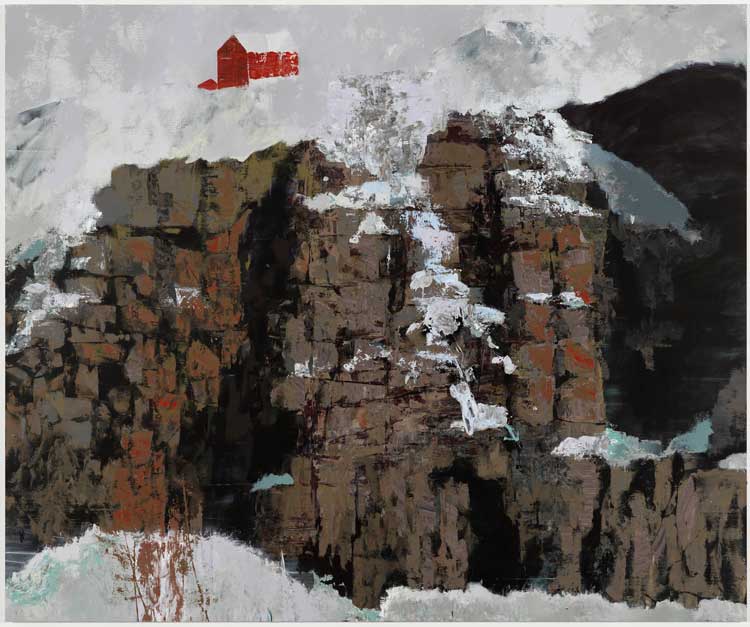
Mohammed Sami, Rootless, 2023. Mixed media on linen, 290.5 x 349 cm (114 3/8 x 137 3/8 in). Photo: Marcus Leith. Courtesy the artist, Modern Art, London and Luhring Augustine, New York.
Sami’s work has an inscrutability that makes it a negative image of the message-driven art he was trained to make. In this, he rejects many current trends. “Most contemporary artists,” he told Artfund in 2023, “nowadays, they’re making propaganda. Even artists here in London, subconsciously, work with ideologies.” Although Sami’s paintings are related to conflict, they evoke scene and times rather than insist on a reading. You can never be sure what exactly they depict. A Midnight Winter Dream (2023) is the most mysterious work here. It depicts a black surface covered in tally marks that appear to have been scored into the linen. Two white tubes float above them and almost meet. They might simply be chalks. But their horizontality conveys a sense of motion, as if they are about to collide. Yet here, as elsewhere, the violence is lightly suggested. Sami’s ambiguity is all part of his work’s allure.
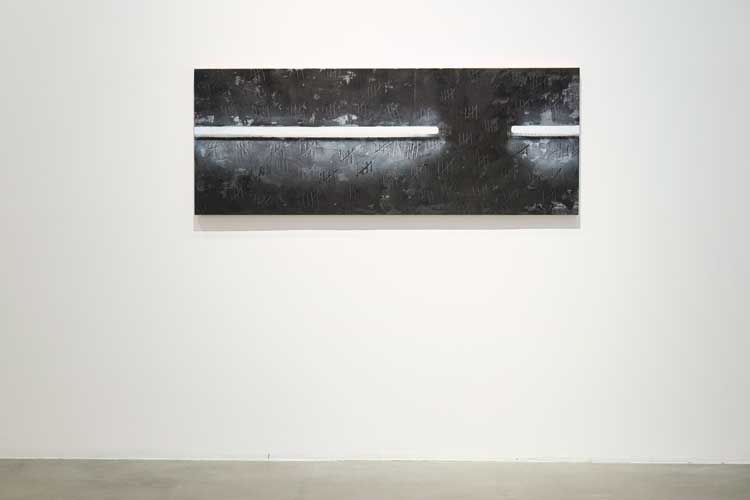
Mohammed Sami, Isthmus. Installation view, Fondazione Sandretto Re Rebaudengo, Turin, Italy, 19 March – 13 October 2024. Courtesy the artist and Fondazione Sandretto Re Rebaudengo. Photo: Giorgio Perottino.